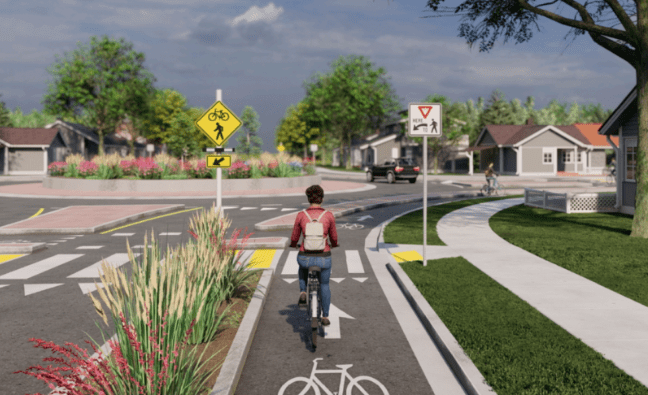Editor's note: This article was written in response to our coverage of National Roundabouts Week 2022. Read the other articles in the series here.
As roundabouts decrease traffic deaths for drivers, some designs of the controversial traffic treatment may actually increase non-deadly collisions for people on bikes. while scaring others off riding entirely, a series of studies suggests — and its raising thorny questions about who might get hurt along the road to Vision Zero.
As part of an ongoing study of the safety impacts of roundabouts, University of Utah-based researchers Patrick Singleton and Nirajan Poudel surveyed 49 studies from roughly a dozen countries and concluded that, on the aggregate, roundabouts may actually increase crashes between bicyclists and drivers — and in some cases, they increase serious injuries and deaths of people on two wheels, too.

The operative word in that sentence, of course, is "may" — and Singleton is careful to point out that not all roundabouts are created equal. Researchers in Belgium, for instance, recorded a staggering 93 percent increase in injury crashes at the intersections that weren't outfitted with accompanying protected bike lanes; meanwhile, Danish researchers studied roundabouts that did have separated lanes, and logged an almost-as-staggering 84 percent reduction in crashes. United States academics, by contrast, often struggled to draw any definitive conclusions, because there were so few roundabouts, crashes, or even simply bicyclists in U.S. communities.
But Singleton still says that roundabout safety deserves more scrutiny, particularly in light of the many studies in their sample that examined how unsafe cyclists feel when riding in many of them. Though actual crash data is often treated as the gold standard of safety metrics, other research shows that low levels of "perceived safety" can dissuade people not just from riding at a certain intersection, but from riding entirely.
"We took a very broad and loose definition of 'safety' in this review," Singleton added. "The end goal of Vision Zero, of course, is that we want to reduce injuries and deaths on our roadways. But the process of getting there matters, so we wanted to assess perceptions of comfort and safety as well."
In subsequent studies, Singleton and Poudel looked more deeply into cyclists' perceptions of roundabout safety, interviewing 600 U.S. riders about what specific designs were most appealing to them and analyzing commonalities between their preferences.
The most popular options, they found, had "one (rather than two) lanes, lower traffic volumes, and more robust bicycle facilities — especially separated bicycle lanes (a 'protected roundabout')."
Which is, to put it bluntly, pretty much nothing like what the average U.S. roundabout looks like at all.
"Current design guidance in the U.S. basically says to either let cyclists take the lane like a driver, or give them a ramp to ride up on the sidewalk," Singleton added. "But our study suggests neither of those are desirable to bicyclists."
Part of the reason, Singleton says, is what psychologists call "inattentional blindness," when drivers physically see someone unexpected — like a cyclist riding right along next to them, or even on a sidewalk— but their brains fail to truly register that the unexpected person is there, because the environment doesn't clearly signal that they belong.
"If I’m a driver, I expect to mostly see things in the driving lane that are about the same size and speed as a car," Singleton adds. "Needless to say, that’s not what a cyclist looks like at all. ... As engineers and planners, we need to understand that 'looking' and 'seeing' are different things, and we need to design intersections to highlight vulnerable road users in many different ways."
Singleton — who is also a civil engineer himself — says that in addition to protected lanes, lots of signs and pavement markings, as well as good setbacks can also help ensure motorists don't strike bikers even when they're looking right at them.
But he also recognizes that great roundabouts that incorporate those recommendations can be significantly more expensive and complicated to install — and that even some imperfect ones can significantly cut crash severity when compared to signalized intersections, if not always crash volumes themselves. How transportation leaders negotiate those tradeoffs in the context of a Vision Zero plan, though, is a complicated political question that Singleton says it's up to others to answer.
"I’m lucky that I’m the researcher and not the policymaker," he laughs. "Hopefully I can provide information, and they can wrestle with those kinds of dilemmas. In the U.S., we’ve had quite a bit of experience to suggest that roundabouts are safer in a lot of situations. My best recommendation now is, let's make them even better for bicyclists."






